 |

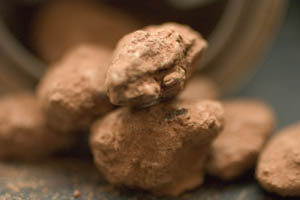 |
From her grandmother’s recipe, Ariella Toeman makes these magnificent chocolate and cocoa-covered pralines—caramelized almonds. There are several definitions of praline, as you’ll read below.
|
Alas, there are no more fabulous Cocoa Nuts: Founder Ariella Toeman has retired for the moment to raise her family. However...
Enjoy the HISTORY OF PRALINES, below. |
Cocoa Nuts:
Praline Prayers Answered
Recently, when a fellow chocolate writer wanted to give us a gift that she thought would be a wonderful new discovery, she sent us all six flavors of Cocoa Nuts pralines from Cocoa Designs in San Francisco. Little did she know, we had been enjoying these gourmet almond and chocolate treats for more than a year. But the gift reminded us that we were remiss in writing them up as an Editors’ top pick in THE NIBBLE. (Let us add that we were thrilled to have another batch to nibble on.)
Pralines come and pralines go, Simon and Garfunkel might sing, and never have a point of view. The point of view of Cocoa Designs is to make classic French almond pralines, then lightly coat them in chocolate and cocoa powder. It’s an artisanal craft: the finest whole nuts are first hand-roasted and caramelized (sugar-coated) in small batches on top of the stove. They are then hand-dipped in the world’s best couverture chocolate and rolled in the best cocoa powders.
The result is a wonderfully fresh, crunchy praline covered in exquisitely good chocolate and cocoa—not so much covered in chocolate, actually, but kissed by it. These are first and foremost almond pralines, with a touch of chocolate flavor. Think light almonds, not rich, heavy, chocolate-enrobed-nuts from the bonbon box. These you can enjoy anytime:
- With coffee or espresso, tea or hot chocolate (or a glass of milk).
- After dinner, with Port or a dessert wine.
- As a counterpoint to sweeter treats on a dessert plate; or to glamorize ice cream, cakes and pies.
- In a nut dish in the parlor.
- For a treat, mete out three-to-six pralines and be very satisfied.
- As a rejuvenator, think of the almonds as protein, with bonus chocolate antioxidants (we claim no credentials as a health writer—just as a spin doctor).
|
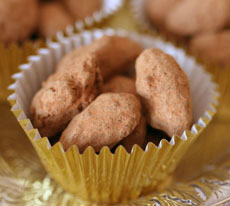 |
| Add some Cocoa Nuts pralines to a dessert plate. |
Cocoa Nuts Flavors
Cocoa Nuts has quite the pedigree. They are made by Ariella Toeman, a pastry chef trained at Le Cordon Bleu in Paris, with credits at fine restaurants in Paris, New York and San Francisco. After leaving restaurant life to specialize in wedding cakes, she began to make pralines from her grandmother’s recipe. They became such a hit that they engendered the Cocoa Nuts line.
While the classic praline is simply a caramelized almond, the Cocoa Nuts spin is the addition of chocolate and a dusting of cocoa plus flavorings—a kind of contemporary chocolate truffle approach that lets us look at pralines in a new way. Cocoa Nuts comes in six flavors, from simple but profound to sophisticated and complex. All are superb and fall under the category of “products you will be thrilled to have discovered” (like each of THE NIBBLE’s weekly selections). The flavors include:
- Noir. Dipped in rich dark chocolate with 58% Venezuelan cacao, then dusted in a French cocoa powder, these pralines have the most pronounced chocolate flavor and are perfect for people seeking a true chocolate-almond marriage.
- Lait. Dipped in creamy milk chocolate and rolled in a subtle Scharffen Berger cocoa powder, this flavor presents itself as more of a cocoa-dusted almond.
- Café. Dipped in extra dark chocolate with 73% Venezuelan cacao, then dusted in freshly ground espresso powder and French cocoa powder, the taste is of almonds with an espresso top note and an undertone of mocha.
- Épices. Dipped in dark chocolate with 61% Venezuelan cacao, rolled in raw cocoa powder and dusted with a blend of allspice, black pepper, cloves and nutmeg, this is the more complex of the two spice blends (we like both, but our personal preference is for this one).
- Aztec. Dipped in dark chocolate with 61% Venezuelan cacao, rolled in natural cocoa powder and dusted in a spice blend that includes New Mexican chile powder and Batavia cinnamon, this is not a hot, spicy Aztec blend. Cinnamon is the top note with chile providing subtle warmth and flavor in the mid-palate and finish. Anyone can enjoy it.
- Mon Amour. This praline is more flavor-forward than the others. Dipped in extra dark chocolate with 73% Venezuelan cacao, it is then coated in real raspberry purée and bitter cocoa powder. After luxuriating in the pronounced, sweet, fresh raspberry flavor mixed with bittersweet chocolate and crunchy almond, we were ready to call Mon Amour, our amour.
White chocolate Cocoa Nuts pralines are available for wedding favors, and custom flavors can be created (one NIBBLE reader, who is introducing a new liqueur, is considering a Cocoa Nuts blend flavored with the liqueur as gifts for the product launch party).
For our chocophile readers: the couvertures used include Cocoa Barry, El Rey, and Scharffen Berger; the brands are matched to the flavors with which they work best. Similarly, both Schokinag and Valrhona cocoa powders are used—in smoky, subtle, raw, dark, or natural varieties, depending on the flavor of praline. |
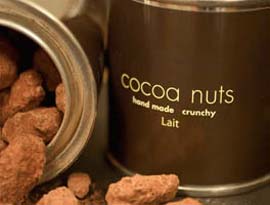
Cocoa Nuts in their traditional gift tin. Shown, Lait, or milk-chocolate-covered pralines. |
If you’d like to learn more about pralines in general—it’s one of the more confusing terms you may come across—read the yellow box below. The product review continues below.
About Pralines
- Pralines (pray-LEEN in English, pra-LEEN in French). The first pralines, invented in France, were whole almonds caramelized in sugar (i.e., the nut is roasted and coated lightly in sugar). Originally spelled praslines, they were named after the French soldier and diplomat Marshal du Plessis-Praslin (1598-1675), whose cook, Clément Lassagne invented them in 1636. After retiring from the marshal’s service, Lassagne founded the Maison de la Praline, a confectioner’s shop that still exists in the town of Montargis, 110 km south of Paris. In addition to fine pralines sold by confectioners, pralines are sold in small paper sacks by street vendors in Europe and elsewhere (we’ve enjoyed them in several American cities). Today hazelnut pralines are also popular.
- The marketplace has taken the word praline and used it to describe multiple products. Whenever you see the word praline, nuts are involved; but the word often does not refer to the original caramelized almond.
- Praline paste, also called praliné (prah-lee-NAY) is a ground nut paste made from almonds or hazelnuts and sugar. It has been used in French patisserie since the 16th century to make pastries and to flavor mousse, buttercream and ice cream.
- Hazelnut praliné is a roasted and caramelized nut paste invented during a chocolate shortage in the 19th century in Turin, Italy. In Italy it is known as gianduja (jon-DOO-ya). It is popularly combined with chocolate and used in other confections.
- In Germany and Belgium, a praline is any filled chocolate. While the French-speaking Belgians call any filled chocolate a praline, the French-speaking French, who invented the caramelized nut praline, can actually buy chocolates filled with praline paste called...pralines. In Great Britain, the term can refer to either the filling for chocolates, or less commonly, to the original almond pralines. As you will see in the next bullet, Americans call a non-chocolate, non-almond brown sugar confection a praline. You have every right to be confused.
- Anyone who has been to Louisiana or Texas knows that a praline (pronounced PRAY-leen or PRAW-leen) is a flat, round, creamy candy patty dotted with crunchy pecans. Early Creoles began using local pecans as the nuts, instead of the almonds or hazelnuts used in the French confection. The product evolved into a candy made of brown sugar, butter and cream and cooked to a soft-ball stage like fudge, but filled with pecans and spooned onto wax paper to form patties. It is called a praline but has absolutely nothing in common with French—or any European—pralines.
- Praline also can refer to French praline powder—caramelized almonds or hazelnuts that are pulverized and sprinkled on ice cream, layered into parfaits, sprinkled on sautéed apples or pears, on cakes and cupcakes, folded into whipped cream, and otherwise used to instantly transform plain desserts into something more elegant. You can find praline powder in specialty stores and baking stores, or you can make your own simply by pulverizing pralines (plain, not chocolate-coated) in a food processor.
- To bring the confusion full-circle, the French also refer to pralines as dragées (drah-ZHAY). Dragées are also sugar-coated almonds; but technically they are almonds encapsulated in a hard-shell coating. We know them as Jordan almonds.
- As language and usage evolve, so will additional applications of “praline.”
|
As gifts go, Cocoa Nuts pralines are a special product. There are lots of confections out there called “pralines,” but none, we wager, as good as these. They are certain to be appreciated by anyone who receives a box.
We keep an assortment of flavors on hand for “general gift inventory”: host and hostess gifts, get well gifts, thank-you gifts—even your dentist would enjoy a tin. Unopened, they have a long shelf life—we’ve opened tins we’ve had for a year, and they taste delightfully crunchy and fresh.
Wedding and Party Favors & Corporate Gifts
Cocoa Nuts pralines are wonderful wedding favors. For centuries, almonds have been given to wedding guests because they represent health, wealth, happiness, fertility and long life for the wedding couple. Cocoa Nuts flavors are available in a variety of packages suitable for weddings, anniversaries, and other parties, customized with color-coordinated ribbons, monograms, and names. Custom tin labeling, shown in the photos below, can be done for any corporate message as well.
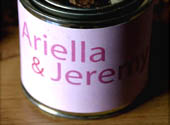 |
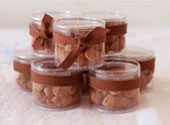 |
 |
| Gift tin with a custom label. |
Clear box packaging. |
Traditional white gift box. |
And, everyone else can order the standard chocolate brown-wrapped tin, simply labeled“Cocoa Nuts” (shown above with the list of flavors), for everyday munching and gift-giving.
It may sound too cute to say “you’ll go nuts for Cocoa Nuts.” But in this case, the truth is: the pralines are great. Don’t miss them. Buy lots. If you buy just a few tins, you’ll find that they’re so good, you won’t want to give them away. But we would never call you ungenerous for that decision.
— Karen Hochman
FORWARD THIS NIBBLE to your friends who love nuts, chocolate, or sweet treats in general; and to anyone looking for party favors, corporate gifts, or stocking-stuffers.
COCOA DESIGNS
Cocoa Nuts in Noir, Lait, Épices, Café, Aztec,
Mon Amour
- 4 Ounce Gift Tin
$6.99
- 8 Ounce Gift Tin
$9.99
- 8 Ounce Zip Bag
$7.50
- Wedding Favors
Minimum Order of 50 Pieces
Prices range from $2.25 to $12.00
Purchase online at CocoaDesigns.com
Prices are verified at publication but are subject to change. Shipping is additional.
The November issue of THE NIBBLE magazine, featuring dozens of product reviews and articles about Thanksgiving entertaining, seasonal treats, and hostess gifts, is now available online. Click here to view the Table of Contents.
|
|
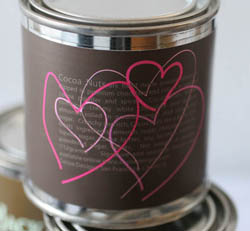
|
Two custom labels applied to a standard gift tin of
Mon Amour raspberry-flavored Cocoa Nuts—perfect
for engagement, anniversary, and wedding favors. |
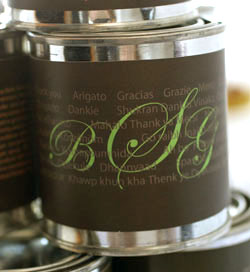 |
learn more about candies and how they are made
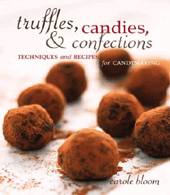 |
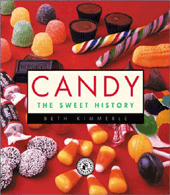 |
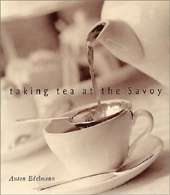 |
Truffles, Candies, and Confections: Techniques and Recipes for Candymaking, by Carole Bloom. Pralines are just one treat in the large and exciting world of nut and candy confections. This book contains over 90 candy recipes that you can actually make yourself. Click here for more information. |
Candy: The Sweet History, by Beth Kimmerle. Those with a refined sweet tooth will appreciate this book’s approach to candy. It’s packed with facts and surprising details about candy and what it has meant to society for centuries (we know what it means to us!). Click here for more information. |
Taking Tea at the Savoy, by Anton Edelmann. This lovely volume features everything you need to have an elegant tea party: 50 delectable recipes for teacakes, sandwiches, and other sweet and savory accompaniments. Don’t forget to include Cocoa Nuts pralines. Click here for more information. |
Some pieces to accompany your pralines
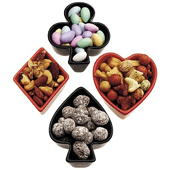 |
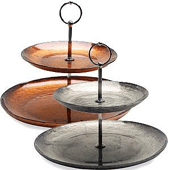 |
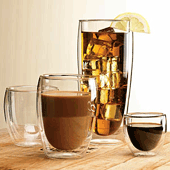 |
Suite Dishes. You don’t have to make a tough choice: you can serve four different Cocoa Nuts praline flavors in these candy and nut dishes. They pay homage to the suites of a deck of playing cards, but you don’t need to schedule a card game to enjoy the clever design. Click here for more information. |
Glamorous Metallic Glass Stand. You don’t have to have tea at the Ritz to enjoy a two-tiered serving stand. For elegant entertaining, present a top tier of pralines and a tier of cookies and other treats— sweets like petit fours, tarts, and brownies, or savories like tea sandwiches and hors d’oeuvres. Click here for more information. |
Bodum Pavina Double-Walled Insulated Glassware. Enjoy your pralines with espresso, coffee or any beverage with no need for coasters. We use these glasses every day: we can set them down anywhere because they eliminate surface moisture for both hot and cold beverages. Beautiful and practical! Click here for more information. |
FOR ADDITIONAL INFORMATION, special offers,
contests, opinion surveys, THE NIBBLE
back issues archive, product gift-finder, links to our favorite
food websites, and the ability to nominate YOUR favorite nibbles,
visit TheNibble.com.
Do you have friends who would enjoy THE NIBBLE?
Click here to send them an invitation to sign up for their own copy. |
© Copyright 2004-2026 Lifestyle Direct, Inc. All rights
reserved. All information contained herein is subject to change at any time
without notice. All details must be directly confirmed with manufacturers, service
establishments and other third parties. The material in this newsletter may not
be reproduced, distributed, transmitted, cached, or otherwise used, except with
the prior written permission of Lifestyle Direct, Inc.
|
 |
|
 |
















